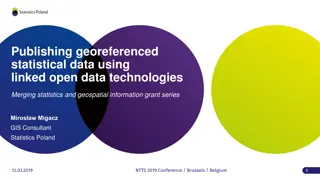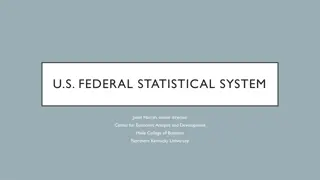Ethical Guidelines for Statistical Practice
Ethical guidelines in statistics emphasize honesty, objectivity, and transparency in presenting findings, avoiding misleading statements, disclosing conflicts of interest, protecting confidentiality, and ensuring data accuracy. Misuse of statistics can stem from pressures to publish, career ambitions, conflicts of interest, or inadequate training. Practitioners are urged to document data sources, make data available for analysis, exercise judgment in selecting statistical procedures, and communicate methodology clearly to clients for ethical statistical practice.
Download Presentation

Please find below an Image/Link to download the presentation.
The content on the website is provided AS IS for your information and personal use only. It may not be sold, licensed, or shared on other websites without obtaining consent from the author.If you encounter any issues during the download, it is possible that the publisher has removed the file from their server.
You are allowed to download the files provided on this website for personal or commercial use, subject to the condition that they are used lawfully. All files are the property of their respective owners.
The content on the website is provided AS IS for your information and personal use only. It may not be sold, licensed, or shared on other websites without obtaining consent from the author.
E N D
Presentation Transcript
Ethics and Statistics Jouko Miettunen, Professor, Academy Research Fellow Center for Life Course Health Research University of Oulu jouko.miettunen@oulu.fi
Ethical guidelines CONTENTS Errors in statistics Test assumptions Multiple testing Power and attrition Clinical trials Publication bias References
Misuses of statistics may (or may not) violate several ethical obligations, such as the duty to be honest, the duty to be objective, the duty to avoid error, and, possibly, the duty to be open? Poor statistics poor science! Gardenier and Resnik 2002
Misuse of statistics why? Pressures to publish, produce results, or obtain grants Career ambitions or aspirations Conflicts of interest and economic motives Inadequate supervision, education, or training Gardenier and Resnik 2002
Ethical guidelines for statistical practice present findings and interpretations honestly and objectively avoid untrue, deceptive, or undocumented statements disclose any financial or other interests that may affect the professional statements collect only the data needed for the purpose of the inquiry protect the confidentiality of information ensure that, whenever data are transferred to other persons or organizations, this transfer conforms with the established confidentiality pledges, and require written assurance from the recipients of the data that the measures employed to protect confidentiality will be at least equal to those originally pledged Use filesender programs and engagement forms American Statistical Association 1999 (www.amstat.org)
Ethical guidelines for statistical practice Be prepared to document data sources used in an inquiry and known inaccuracies in the data Make the data available for analysis by other responsible parties Recognize that the selection of a statistical procedure may to some extent be a matter of judgment Recognizing that a client (researcher) or employer may be unfamiliar with statistical practice Apply statistical procedures without concern for a favorable outcome State clearly, accurately, and completely to a client the characteristics of alternate statistical procedures along with the recommended methodology and the usefulness and implications of all possible approaches
Errors in analyses Easy to use incorrectly Not always easy to detect On purpose vs. not? Who is doing analyses? Differences in programs How often? Lang T. Twenty statistical errors even you can find in biomedical research articles. Croatian Med J 2004; 45:361-70.
Test assumptions Normality Visual check is important Mean vs. Median Assumption in regression analysis Transformations Can complicate interpretation Osborne and Waters 2002
Test assumptions Independence of observations Unusual event if well designed study In large studies usually not a problem Reliability of measurements Poor reliability reduces power Osborne and Waters 2002
Test assumptions Homoscedasticity = variance should be the same across all levels of the variable Assumed regression analysis High heteroscedasticity decreases power Osborne and Waters 2002
Test assumptions Non-linear associations reduce power in standard multiple regression Osborne and Waters 2002
Multiple testing Setting hypotheses is important! Data fishing Corrections for multiple testings Bootstrapping methods Post-Hoc testing of ANOVAs Bonferroni correction Benjamini-Hochberg procedure
Bonferroni correction Simple, but conservative methods Level of statistical significance of p=0.05 will be changed by dividing it with number of tests Example: 25 tests Without correction 5 variables are significant (p<0.05) With corrected level (p<0.002) one significant variables
Benjamini-Hochberg correction Q=0.05 Q=0.25 (i) Significances are ranked by order (Rank, i) Benjamini-Hochberg critical value is calculated with formula (i/m)Q, where i=rank, m=# of tests ja Q=selected false discovery rate (how many false positive findings are accepted) 0.002 0.004 0.006 0.008 Example: Q=0.25 (often Q=0.05) In the example, first 5 are significant (even whole milk and white meat although P > critical value, as P smaller than P in variable proteins )
Interpretation Statistical significance vs. effect? The difference between significant and not significant is not itself statistically significant Absence of evidence is not evidence of absence
Statistical Power http://www.bayesian-inference.com/images/ban-samplesize.png
Power analyses Well done sample size (power) analyses should be part of all study plans Too much research done with small samples ethical problem!
Power analyses Samples sizes in clinical trials are usually small, e.g. Rheumatoid arthritis: median sample size 54 patients (196 trials) Skin diseases: 46 patients (73 trials) Schizophrenia: 65 patients (2000 trials) Sample size is usually not based on anything! Post hoc power calculations are unnecessary, confidence intervals tell about power Moher et al. CONSORT statement 2010
Power analyses Need to know Number of persons Prevalence of the primary outcome (expected number of events) Assumptions to be made Effect size Significance level ( ) Statistical power (1- )
Alpha i.e. significance level (e.g. 0.05 or 5%) Probabibility that difference is found but it is not real (false positive finding) Beta i.e. power (e.g. 0.8 or 80%) Probability that the found difference is real Interim analysis is a a priori planned analyses done in an ongoing trial, reasons for this ethical or economical error increases Power can be inadequate? Suresh KP & Chandrashekara S. J Hum Reprod Sci 2012; 5: 7 13.
Different situations Difference in means Difference in proportions Multiple variable analyses Different software Web pages Specific software SPSS sample power, http://homepage.stat.uiowa.edu/~rlenth/Power/index.html
Study design In clinical trials smaller sample size is adequate Variance Larger variance requires larger sample sizes to detect group differences Follow-up studies: take into account attrition! Suresh KP & Chandrashekara S. J Hum Reprod Sci 2012; 5: 7 13.
Attrition Patients and doctors participate poorly to clinical trials. Doctors want to decide about the treatment of their patients. Believe to standard care is strong! If <80% included in the final analyses, the results should not be taken into account (EBM toolkit 2006).
Lieberman JA, et al. Antipsychotic drug effects on brain morphology in first-episode psychosis. Arch Gen Psychiatry. 2005;62:361-70. OBJECTIVE: To test a priori hypotheses that olanzapine-treated patients have less change over time in whole brain gray matter volumes and lateral ventricle volumes than haloperidol-treated patients. DESIGN: Longitudinal, randomized, controlled, multisite, double-blind study. Patients treated and followed up for up to 104 weeks. Neurocognitive and magnetic resonance imaging (MRI) assessments performed at weeks 0 (baseline), 12, 24, 52, and 104. INTERVENTIONS: Random allocation to a conventional antipsychotic, haloperidol (2-20 mg/d), or an atypical antipsychotic, olanzapine (5-20 mg/d). RESULTS: Of 263 randomized patients, 161 had baseline and at least 1 postbaseline MRI evaluation. Haloperidol- treated patients exhibited significant decreases in gray matter volume, whereas olanzapine-treated patients did not. CONCLUSIONS: Haloperidol was associated with significant reductions in gray matter volume, whereas olanzapine was not. The differential treatment effects on brain morphology could be due to haloperidol-associated toxicity or greater therapeutic effects of olanzapine.
Lieberman JA, et al. Antipsychotic drug effects on brain morphology in first-episode psychosis. Arch Gen Psychiatry. 2005;62:361-70.
Missing data People do not participate or are lost to follow-up? Missing data on variables? Can be a problem? Describe? Analyze? Take into account? Weighting? Multiple imputation?
Reporting attrition Miettunen J, Murray GK, Jones PB, M ki P, Ebeling H, Taanila A, Joukamaa M, Savolainen J, T rm nen S, J rvelin MR, Veijola J, Moilanen I. Longitudinal associations between childhood and externalizing and psychopathology substance use. adulthood internalizing adolescent and Psychol Med. 2014 Jun; 44(8):1727- 38.
http://jama.jamanetwork.com/data/journals/jama/24277/m_jmn120028fa.pnghttp://jama.jamanetwork.com/data/journals/jama/24277/m_jmn120028fa.png Intention-to-treat Intention-to-treat analysis, i.e. the data is analyzed based on the original randomization The effect of randomization remains!
Tom Lang. Croatian Medical Journal 2004;45:361-70 - if a predictor, can be used as a covariate in analyses
Methods Selection of interventions Grounds for interventions? Length of the study? Generalizability? Primary vs. secondary outcome Subgroup analyses?
Results Statistical methods should be clearly described Confidence intervals should be the primary method to describe the certainty of the effect exact p-values (not <0.05 etc.)
Discussion Limitations? Comparison to previous studies? Generalizability? Interpretation? Conclusions?
Inadequate reporting of harms Ioannidis JP, et al. Ann Intern Med 2004; 141:781-8. 1. Using generic or vague statements, such as the drug was generally well tolerated or the comparator drug was relatively poorly tolerated. 2. Failing to provide separate data for each study arm. 3. Providing summed numbers for all adverse events for each study arm, without separate data for each type of adverse event. 4. Providing summed numbers for a specific type of adverse event, regardless of severity or seriousness. 5. Reporting only the adverse events observed at a certain frequency or rate threshold (for example, >3% or >10% of participants). 6. Reporting only the adverse events that reach a P value threshold in the comparison of the randomized arms (for example, P > 0.05). 7. Reporting measures of central tendency (for example, means or medians) for continuous variables without any information on extreme values. 8. Improperly handling or disregarding the relative timing of the events, when timing is an important determinant of the adverse event in question. 9. Not distinguishing between patients with 1 adverse event and participants with multiple adverse events. 10. Providing statements about whether data were statistically significant without giving the exact counts of events. 11. Not providing data on harms for all randomly assigned participants. To study adverse effects, one can utilize observational studies!
Examples of poor reporting of non-significant results a clear, strong trend (p=0.09) an encouraging trend (p<0.1) an important trend (p=0.066) approached conventional levels of significance (p<0.10) below (but verging on) the statistical significant level (p>0.05) failed to reach significance on this occasion (p=0.09) flirting with conventional levels of significance (p>0.1) leaning towards significance (p=0.15) narrowly escaped significance (p=0.08) not conventionally significant (p=0.089), but.. not significant in the narrow sense of the word (p=0.29) on the very fringes of significance (p=0.099) http://mchankins.wordpress.com/2013/04/21/still-not-significant-2/ 38
Meta-analyses Publication bias can be estimated with a funnel plot We assume that the most exact (usually largest) studies get average results, smaller studies should be in both sizes of the average Trim and fill Rosenberg. Evolution 2005;59: 464-8
Funnel plot Corpet & Pierre Eur J Cancer 2005 (http://corpet.free.fr/MAaspirin.html)
TrimandFill Method to correct for publication bias
Why most published research findings are false? 1. The smaller the studies conducted in a scientific field, the less likely the research findings are to be true. The smaller the effect sizes in a scientific field, the less likely the research findings are to be true. The greater the number and the lesser the selection of tested relationships in a scientific field, the less likely the research findings are to be true. The greater the flexibility in designs, definitions, outcomes, and analytical modes in a scientific field, the less likely the research findings are to be true. The greater the financial and other interests and prejudices in a scientific field, the less likely the research findings are to be true. The hotter a scientific field (with more scientific teams involved), the less likely the research findings are to be true. 2. 3. 4. 5. 6. Ioannidis JPA. Why most published research findings are false. PLOS Medicine 2005;2:e124.
Some solutions ? More teaching of statistics? Guidelines? Team work? Registration of studies? Publicly available data? Sensitivity analyses?
Literature Altman DG. Statistics and ethics in medical research. Misuse of statistics is unethical. Br Med J 1980; 281: 1182 4. DeMets DL. Statistics and ethics in medical research. Science and Engineering Ethics 1999; 5:97-117. Easterbrook PJ, et al. Publication bias in clinical research. Lancet 1991; 337:867 72. Gardenier J & Resnik D. The misuse of statistics: concepts, tools, and a research agenda. Accountability in Research: Policies and Quality Assurance 2002; 9:65- 74. Ioannidis JPA. Why most published research findings are false. PLOS Medicine 2005;2:e124. Hutton JL. The ethics of randomised controlled trials: a matter of statistical belief? Health Care Anal 1996; 4:95-102 Lang T. Twenty statistical errors even you can find in biomedical research articles. Croatian Med J 2004; 45:361-70.
Literature Ioannidis JPA. Why most published research findings are false. PLOS Medicine 2005;2:e124. Mark DB, et al. Understanding the role of p values and hypothesis tests in clinical research. JAMA Cardiol. 2016; 1(9):1048-1054. Moher D, et al. CONSORT 2010 explanation and elaboration: updated guidelines for reporting parallel group randomised trials. BMJ 2010; 340:c869. Osborne JW & Waters E. Four assumptions of multiple regression that researchers should always test. Practical Assessment, Research, and Evaluation 2002: 8 (available online). Palmer CR. Ethics and statistical methodology in clinical trials. J Med Ethics 1993; 19:219-22. Suresh KP & Chandrashekara S. Sample size estimation and power analysis for clinical research studies. J Hum Reprod Sci 2012; 5: 7 13.
Thank you! jouko.miettunen@oulu.fi www.joukomiettunen.net

 undefined
undefined






















